人教版(2019)必修第一册Unit 4 Natural Disasters Discovering Useful Structures 课件(共20张PPT)
文档属性
| 名称 | 人教版(2019)必修第一册Unit 4 Natural Disasters Discovering Useful Structures 课件(共20张PPT) | 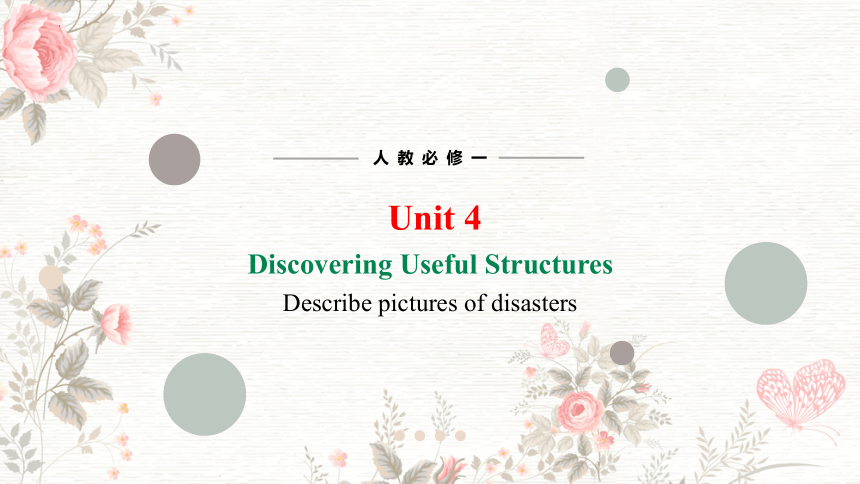 | |
| 格式 | pptx | ||
| 文件大小 | 7.0MB | ||
| 资源类型 | 教案 | ||
| 版本资源 | 人教版(2019) | ||
| 科目 | 英语 | ||
| 更新时间 | 2023-11-29 23:04:51 | ||
图片预览

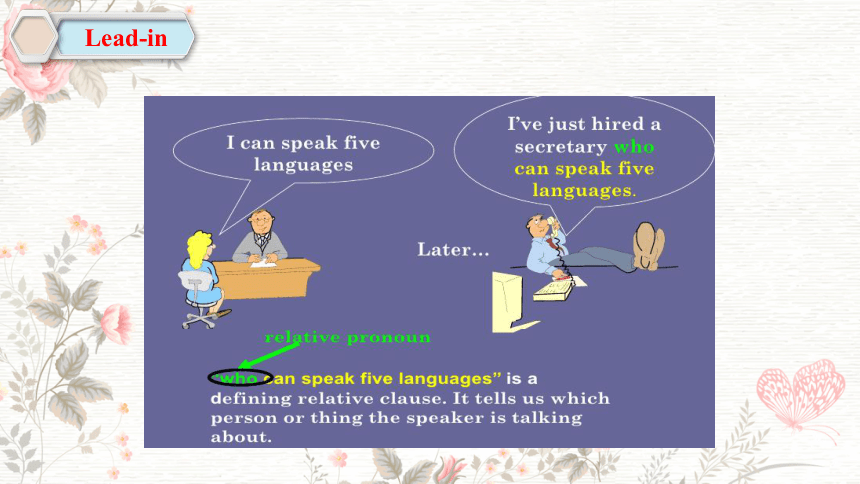
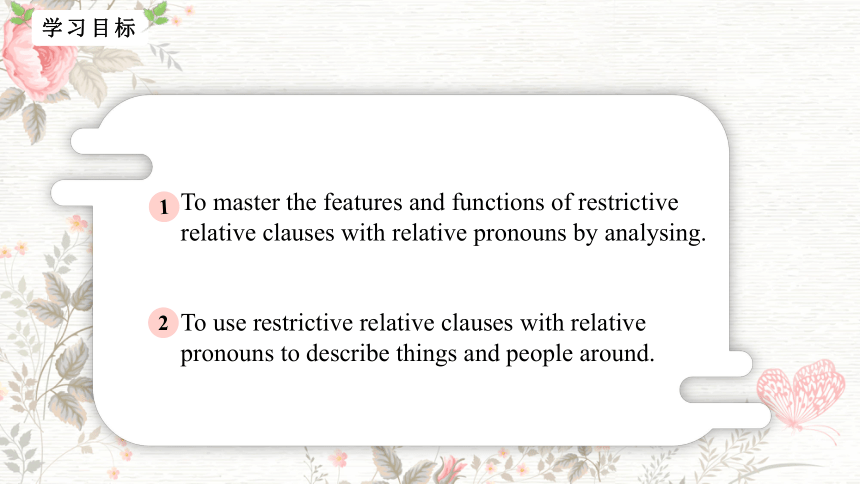
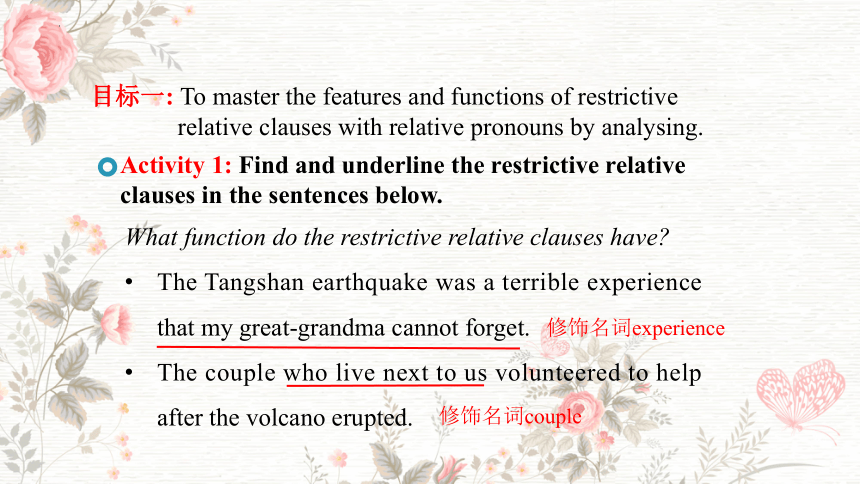
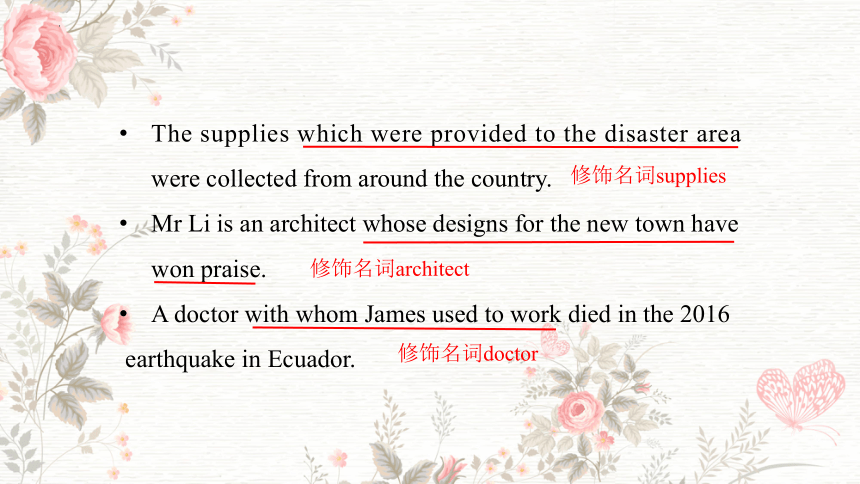
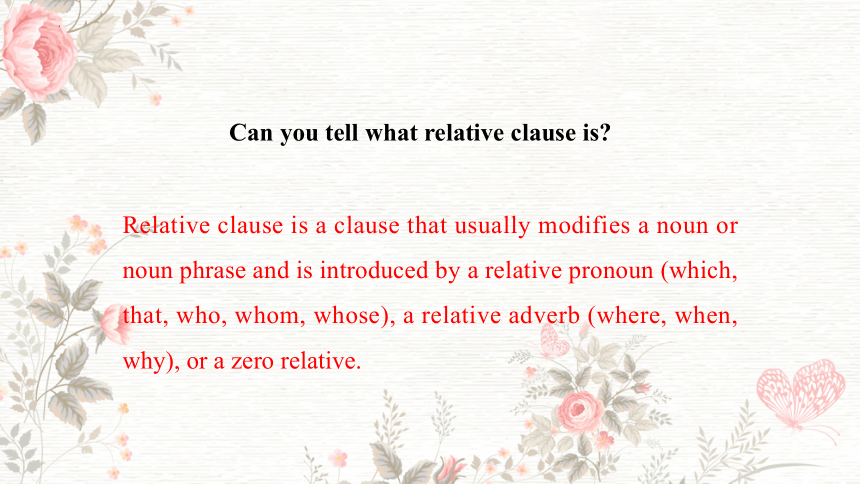
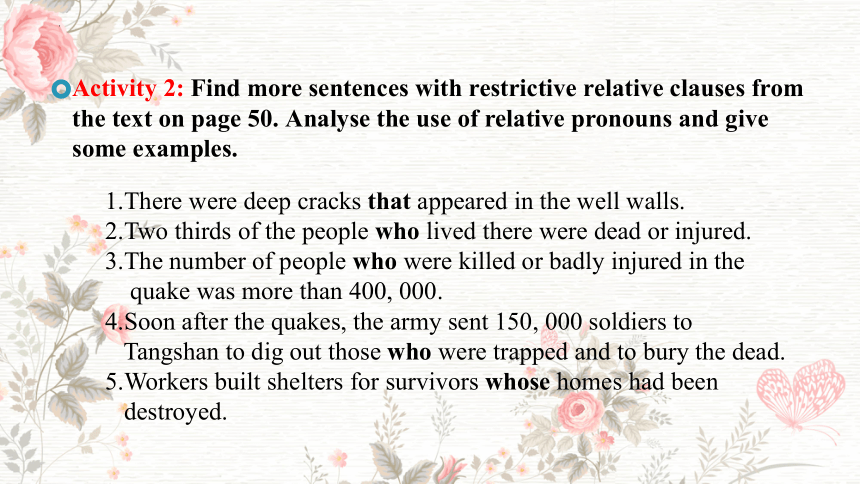
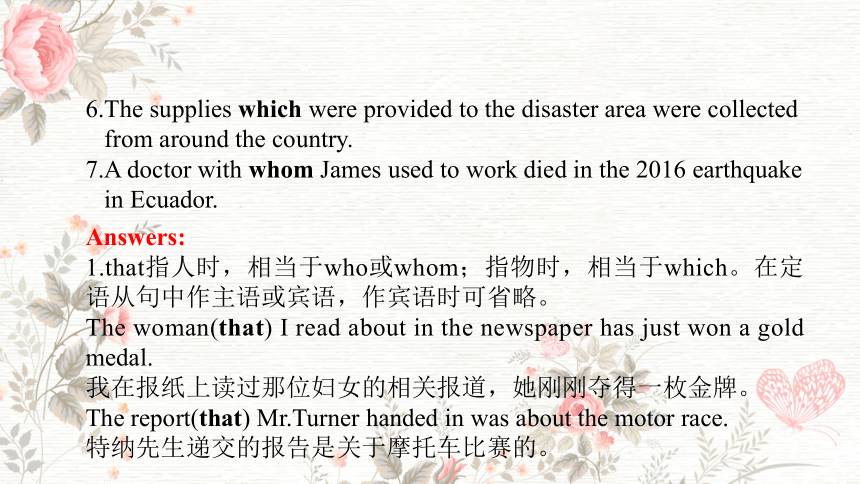

文档简介
(共20张PPT)
人教必修一
Unit 4
Discovering Useful Structures
Describe pictures of disasters
教学目
Lead-in
1
2
To master the features and functions of restrictive relative clauses with relative pronouns by analysing.
To use restrictive relative clauses with relative pronouns to describe things and people around.
目标一: To master the features and functions of restrictive
relative clauses with relative pronouns by analysing.
Activity 1: Find and underline the restrictive relative clauses in the sentences below.
What function do the restrictive relative clauses have
The Tangshan earthquake was a terrible experience that my great-grandma cannot forget.
The couple who live next to us volunteered to help after the volcano erupted.
修饰名词experience
修饰名词couple
The supplies which were provided to the disaster area were collected from around the country.
Mr Li is an architect whose designs for the new town have won praise.
A doctor with whom James used to work died in the 2016
earthquake in Ecuador.
修饰名词supplies
修饰名词architect
修饰名词doctor
Can you tell what relative clause is
Relative clause is a clause that usually modifies a noun or noun phrase and is introduced by a relative pronoun (which, that, who, whom, whose), a relative adverb (where, when, why), or a zero relative.
Activity 2: Find more sentences with restrictive relative clauses from the text on page 50. Analyse the use of relative pronouns and give some examples.
1.There were deep cracks that appeared in the well walls.
2.Two thirds of the people who lived there were dead or injured.
3.The number of people who were killed or badly injured in the
quake was more than 400, 000.
4.Soon after the quakes, the army sent 150, 000 soldiers to
Tangshan to dig out those who were trapped and to bury the dead.
5.Workers built shelters for survivors whose homes had been
destroyed.
6.The supplies which were provided to the disaster area were collected
from around the country.
7.A doctor with whom James used to work died in the 2016 earthquake
in Ecuador.
Answers:
1.that指人时,相当于who或whom;指物时,相当于which。在定语从句中作主语或宾语,作宾语时可省略。
The woman(that) I read about in the newspaper has just won a gold medal.
我在报纸上读过那位妇女的相关报道,她刚刚夺得一枚金牌。
The report(that) Mr.Turner handed in was about the motor race.
特纳先生递交的报告是关于摩托车比赛的。
2.who指人,在从句中作主语或宾语,作宾语时可省略。
The man who is talking with my father is a teacher.
正在和我父亲说话的那个人是个教师。
The girl (who) I met yesterday was his sister.
我昨天见到的那个女孩是他的妹妹。
3.whose既可指人,也可指物。其后接名词,与先行词构成从属关系,在从句中作定语。
This is the scientist whose name is known all over the country.
这就是那位闻名全国的科学家。
Nobody wants the house whose roof has fallen in.
没有人想要这个屋顶已坍塌的房子。
4.which只指物,不指人,可作主语或宾语,作宾语时可省略。
Guilin is a city which has a history of 2,000 years.
桂林是一个有2 000年历史的城市。
The young man was very happy to get back the gold ring(which) he had lost on the train.
那个年轻人找回了在火车上丢失的金戒指,非常高兴。
5.whom指人,在从句中作宾语,常可省略,不能作主语。
The boy(whom)the teacher often praises is their monitor.
老师经常表扬的那个男孩是他们的班长。
(1)关系代词whom在口语或非正式文体中常可用who来代替。
The boy(who/whom/that)we saw yesterday was John's brother.
昨天我们看到的那个男孩是约翰的哥哥。
(2)在从句中作介词的宾语且直接跟在介词后时,用whom, 不用who。
He is a man from whom we are all ready to learn.
他是我们大家都愿意学习的人。
教学目
Attention
Activity 3: Analyse the the following sentences and conclude the special use of relative pronouns of “that” and “which”.
一、 The use of relative pronoun “that”
1.All that can be done has been done.
2.This is the most delicious food that I have ever had.
3.Chatting was the only thing that interested her most.
4.She took photographs of the things and people that she was interested in.
5.Who is the person that is standing at the gate
6.Shanghai is no longer the city that it used to be.
Answers:
以下情况用关系代词“that”:
1.当先行词为all,everything,nothing,anything,little,
much等不定代词或先行词被这些词修饰时;
2.当先行词是序数词、形容词最高级或先行词被序数词
或形容词最高级修饰时;
3.当先行词被the only,the very,the last修饰时;
4.当先行词既指人,又指物时;
5.当主语是以who或which开头的疑问句时,为避免重复
而用that;
6.当先行词在定语从句中作表语时。
二、The use of relative pronoun “which”
1.This is the room in which he lives.
2.Tom came back, which made us very happy.
3.Let me show you the novel that I borrowed from the library which was newly open.
Answers:
以下情况用关系代词“which”;
1.在定语从句中作介词的宾语,且介词位于关系代词前时;
2.引导非限制性定语从句时;
3.在限制性定语从句中,如果有两个定语从句,其中前一句的关系代词是that,那么后一句的关系代词就要用which。
目标二:To use restrictive relative clauses with relative pronouns to describe things and people around.
Activity 1: Complete each sentence with that, which, who, whose, whom or “/”. Then translate the sentences into Chinese.
1.Here are some of the people ____________ homes were destroyed by the typhoon.
2.The terrible shaking of the building woke up all the people ____________ were asleep.
3.The next day, people put up shelters in the open air using anything ____________ they could find.
4.Several days later, most of the buildings ____________ had been damaged by the hurricane were repaired.
5.The injured boy ____________ mother was lost in the disaster was taken to the hospital.
6.The woman wrote a thank-you letter to the soldier by ____________ she was rescued.
7.Is this the young boy ____________ saved several other students trapped under buildings
Answers:
1.whose
这是一些被台风摧毁家园的人们。
2.who
大楼的剧烈震动惊醒了所有睡着的人。
3.that 或 “/”
第二天,人们用能找到的任何东西在露天处搭建庇护所。
4.which 或 that
几天后,大多数被飓风毁坏的建筑都修好了。
5.whose
那个母亲在灾难中丧生的受伤男孩被送到了医院。
6.whom
那位妇女给营救她的士兵写了一封感谢信。
7.who OR that
这是那个救了其他几个被困在建筑下的学生的小男孩吗?
Activity 2: Work with a partner. Take turns to ask each other about the pictures.
Make sentences with restrictive relative clauses using that, which, who, whose, whom.
EXAMPLE:
A: What's the rescue worker doing
B: She is feeding the baby who survived the earthquake.
1. Can you tell us the function of relative pronouns in a sentence
2. What is restrictive relative clause Give us some examples.
人教必修一
Unit 4
Discovering Useful Structures
Describe pictures of disasters
教学目
Lead-in
1
2
To master the features and functions of restrictive relative clauses with relative pronouns by analysing.
To use restrictive relative clauses with relative pronouns to describe things and people around.
目标一: To master the features and functions of restrictive
relative clauses with relative pronouns by analysing.
Activity 1: Find and underline the restrictive relative clauses in the sentences below.
What function do the restrictive relative clauses have
The Tangshan earthquake was a terrible experience that my great-grandma cannot forget.
The couple who live next to us volunteered to help after the volcano erupted.
修饰名词experience
修饰名词couple
The supplies which were provided to the disaster area were collected from around the country.
Mr Li is an architect whose designs for the new town have won praise.
A doctor with whom James used to work died in the 2016
earthquake in Ecuador.
修饰名词supplies
修饰名词architect
修饰名词doctor
Can you tell what relative clause is
Relative clause is a clause that usually modifies a noun or noun phrase and is introduced by a relative pronoun (which, that, who, whom, whose), a relative adverb (where, when, why), or a zero relative.
Activity 2: Find more sentences with restrictive relative clauses from the text on page 50. Analyse the use of relative pronouns and give some examples.
1.There were deep cracks that appeared in the well walls.
2.Two thirds of the people who lived there were dead or injured.
3.The number of people who were killed or badly injured in the
quake was more than 400, 000.
4.Soon after the quakes, the army sent 150, 000 soldiers to
Tangshan to dig out those who were trapped and to bury the dead.
5.Workers built shelters for survivors whose homes had been
destroyed.
6.The supplies which were provided to the disaster area were collected
from around the country.
7.A doctor with whom James used to work died in the 2016 earthquake
in Ecuador.
Answers:
1.that指人时,相当于who或whom;指物时,相当于which。在定语从句中作主语或宾语,作宾语时可省略。
The woman(that) I read about in the newspaper has just won a gold medal.
我在报纸上读过那位妇女的相关报道,她刚刚夺得一枚金牌。
The report(that) Mr.Turner handed in was about the motor race.
特纳先生递交的报告是关于摩托车比赛的。
2.who指人,在从句中作主语或宾语,作宾语时可省略。
The man who is talking with my father is a teacher.
正在和我父亲说话的那个人是个教师。
The girl (who) I met yesterday was his sister.
我昨天见到的那个女孩是他的妹妹。
3.whose既可指人,也可指物。其后接名词,与先行词构成从属关系,在从句中作定语。
This is the scientist whose name is known all over the country.
这就是那位闻名全国的科学家。
Nobody wants the house whose roof has fallen in.
没有人想要这个屋顶已坍塌的房子。
4.which只指物,不指人,可作主语或宾语,作宾语时可省略。
Guilin is a city which has a history of 2,000 years.
桂林是一个有2 000年历史的城市。
The young man was very happy to get back the gold ring(which) he had lost on the train.
那个年轻人找回了在火车上丢失的金戒指,非常高兴。
5.whom指人,在从句中作宾语,常可省略,不能作主语。
The boy(whom)the teacher often praises is their monitor.
老师经常表扬的那个男孩是他们的班长。
(1)关系代词whom在口语或非正式文体中常可用who来代替。
The boy(who/whom/that)we saw yesterday was John's brother.
昨天我们看到的那个男孩是约翰的哥哥。
(2)在从句中作介词的宾语且直接跟在介词后时,用whom, 不用who。
He is a man from whom we are all ready to learn.
他是我们大家都愿意学习的人。
教学目
Attention
Activity 3: Analyse the the following sentences and conclude the special use of relative pronouns of “that” and “which”.
一、 The use of relative pronoun “that”
1.All that can be done has been done.
2.This is the most delicious food that I have ever had.
3.Chatting was the only thing that interested her most.
4.She took photographs of the things and people that she was interested in.
5.Who is the person that is standing at the gate
6.Shanghai is no longer the city that it used to be.
Answers:
以下情况用关系代词“that”:
1.当先行词为all,everything,nothing,anything,little,
much等不定代词或先行词被这些词修饰时;
2.当先行词是序数词、形容词最高级或先行词被序数词
或形容词最高级修饰时;
3.当先行词被the only,the very,the last修饰时;
4.当先行词既指人,又指物时;
5.当主语是以who或which开头的疑问句时,为避免重复
而用that;
6.当先行词在定语从句中作表语时。
二、The use of relative pronoun “which”
1.This is the room in which he lives.
2.Tom came back, which made us very happy.
3.Let me show you the novel that I borrowed from the library which was newly open.
Answers:
以下情况用关系代词“which”;
1.在定语从句中作介词的宾语,且介词位于关系代词前时;
2.引导非限制性定语从句时;
3.在限制性定语从句中,如果有两个定语从句,其中前一句的关系代词是that,那么后一句的关系代词就要用which。
目标二:To use restrictive relative clauses with relative pronouns to describe things and people around.
Activity 1: Complete each sentence with that, which, who, whose, whom or “/”. Then translate the sentences into Chinese.
1.Here are some of the people ____________ homes were destroyed by the typhoon.
2.The terrible shaking of the building woke up all the people ____________ were asleep.
3.The next day, people put up shelters in the open air using anything ____________ they could find.
4.Several days later, most of the buildings ____________ had been damaged by the hurricane were repaired.
5.The injured boy ____________ mother was lost in the disaster was taken to the hospital.
6.The woman wrote a thank-you letter to the soldier by ____________ she was rescued.
7.Is this the young boy ____________ saved several other students trapped under buildings
Answers:
1.whose
这是一些被台风摧毁家园的人们。
2.who
大楼的剧烈震动惊醒了所有睡着的人。
3.that 或 “/”
第二天,人们用能找到的任何东西在露天处搭建庇护所。
4.which 或 that
几天后,大多数被飓风毁坏的建筑都修好了。
5.whose
那个母亲在灾难中丧生的受伤男孩被送到了医院。
6.whom
那位妇女给营救她的士兵写了一封感谢信。
7.who OR that
这是那个救了其他几个被困在建筑下的学生的小男孩吗?
Activity 2: Work with a partner. Take turns to ask each other about the pictures.
Make sentences with restrictive relative clauses using that, which, who, whose, whom.
EXAMPLE:
A: What's the rescue worker doing
B: She is feeding the baby who survived the earthquake.
1. Can you tell us the function of relative pronouns in a sentence
2. What is restrictive relative clause Give us some examples.
